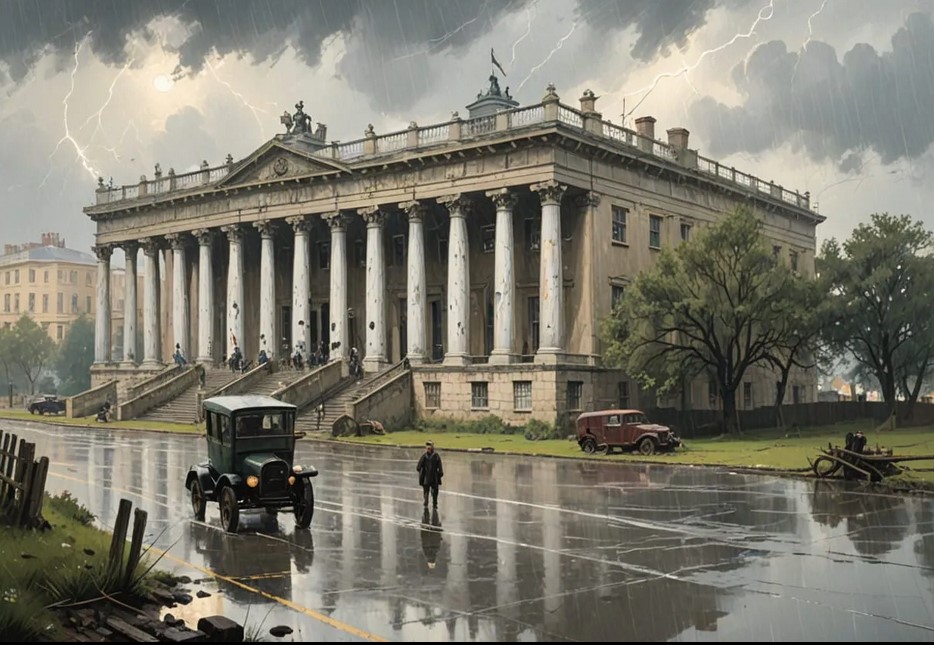Paris Bourse
- Paris -PLBE- Paris - La Belle Époque

Paris Bourse, is the official stock exchange in France.
In the early 19th century, the Paris Bourse's activities found a stable location at the Palais Brongniart, or Palais de la Bourse, built to the designs of architect Alexandre-Théodore Brongniart from 1808 to 1813 and completed by Éloi Labarre from 1813 to 1826.
Brogniart had spontaneously submitted his project, which was a rectangular neoclassical Roman temple with a giant Corinthian colonnade enclosing a vaulted and arcaded central chamber. His designs were greatly admired by Napoleon and won Brogniart a major public commission at the end of his career. Initially praised, the building was later attacked for academic dullness. The authorities had required Brogniart to modify his designs, and after Brogniart's death in 1813, Labarre altered them even further, greatly weakening Brogniart's original intentions. From 1901 to 1905 Jean-Baptiste-Frederic Cavel designed the addition of two lateral wings, resulting in a cruciform plan with innumerable columns. According to the architectural historian Andrew Ayers, these alterations "did nothing to improve the reputation of this uninspiring monument.
History
In the early 19th century, the Paris Bourse's activities found a stable location at the Palais Brongniart, or Palais de la Bourse, built to the designs of architect Alexandre-Théodore Brongniart from 1808 to 1813 and completed by Éloi Labarre from 1813 to 1826. Brongniart had spontaneously submitted his project, which was a rectangular neoclassical Roman temple with a giant Corinthian colonnade enclosing a vaulted and arcaded central chamber. His designs were greatly admired by Napoleon and won Brongniart a major public commission at the end of his career. Initially praised, the building was later attacked for academic dullness. The authorities had required Brongniart to modify his designs, and after Brongniart's death in 1813, Labarre altered them even further, greatly weakening Brongniart's original intentions. From 1901 to 1905, Jean-Baptiste-Frederic Cavel designed the addition of two lateral wings, resulting in a cruciform plan with innumerable columns. According to the architectural historian Andrew Ayers, these alterations "did nothing to improve the reputation of this uninspiring monument."
From the second half of the 19th century, official stock markets in Paris were operated by the Compagnie des agents de change, directed by the elected members of a stockbrokers' syndical council. The number of dealers in each of the different trading areas of the Bourse was limited. There were around 60 agents de change (the official stockbrokers). An agent de change had to be a French citizen, be nominated by a former agent or his estate, and be approved by the Minister of Finance, and he was appointed by decree of the President of the Republic. Officially, the agents de change could not trade for their own account nor even be a counterpart to someone who wanted to buy or sell securities with their aid; they were strictly brokers, that is, intermediaries. In the financial literature, the Paris Bourse is hence referred to as order-driven market, as opposed to quote-driven markets or dealer markets, where price-setting is handled by a dealer or market-maker. In Paris, only agents de change could receive a commission, at a rate fixed by law, for acting as an intermediary. However, parallel arrangements were usual in order to favor some clients' quote. The Commodities Exchange was housed in the same building until 1889, when it moved to the present Bourse de commerce. Moreover, until about the middle of the 20th century, a parallel market known as "La Coulisse" was in operation.
Buildings
Following the collapse of John Law's Mississippi Company in 1721, the Paris bourse was located in his Hôtel de Nevers from 24 September 1724 to 27 June 1793, when it suspended operations in the chaotic context of the French Revolution. It reopened on 10 May 1795 in the Louvre Palace, in Anne of Austria's former summer apartment on the ground floor of the Petite Galerie, and stayed there until 9 September 1795. In September 1795, the Bourse again closed for a few months; it reopened in January 1796 in the Church of Notre-Dame-des-Victoires, then in October 1807, moved to the Palais-Royal, and finally, in March 1818, to the former Couvent des Filles-Saint-Thomas , adjacent to the site where the Palais Brongniart was already in construction. On 6 November 1926, the stock exchange finally moved to the latter building,: 118-119 which was and remains owned by the City of Paris.